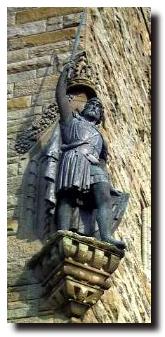- Sir William Wallace (? - 1305)

Famous Scots
- Sir William Wallace (? - 1305)

Introduction
Even before all the razzmatazz of "Braveheart" William Wallace was a national hero in Scotland, set on an equal footing with Robert the Bruce. Since the Mel Gibson film (based in part on the epic poem "Life of Wallace" by "Blind Harry" a 15th century minstrel) there has been an explosion of books on Wallace and many Web pages have been created on the Net. This feature recounts the main aspects of his life and provides a number of links to other Web pages where more detail can be obtained, if required.Wallace's Birth
The name Wallace may be derived from "Walays" the term used by the English to describe anyone who came from Wales. Some of these Welshmen accompanied the Fitz-Alans (later to be the High Stewards of Scotland) and they settled near Paisley - at Elderslie. The Wallaces also owned land at Riccarton, near Kilmarnock and it is possible that Wallace's father was born there. What is fairly certain is that Wallace had an older and younger brother, Malcolm and John. But the date and place of Wallace's birth are both uncertain - the most likely location is Elderslie in Renfrewshire.The Fight Against the English
Due to the untimely deaths of King Alexander III and Queen Margaret, the "Maid of Norway", Scotland found itself towards the end of the 13th century without a monarch and a number of contenders who were vying for the role. King Edward I of England seized the opportunity and offered to "arbitrate". Of course, when his choice of John Balliol began to accept King Edward's instructions, the English king marched into Scotland. Balliol was stripped of his position and English overlords were appointed. Scotland was stripped of precious items as the Stone of Destiny, the Scottish crown, the Black Rood of St Margaret (believed at the time to be remnants of the true Cross) and huge archives of Scotland's national records.
In 1296 Edward summoned 2000 of the landowners and senior clergy to Berwick where they were required to sign an oath of loyalty to him. This became known as the "Ragman Roll".
The epic poem by Blind Harry recounts a number of incidents in Wallace's early life but it is his murder of the Sheriff of Lanark which was recorded in English records which launched Wallace onto the pages of history. A series of skirmishes followed, at various locations around Scotland from Aberdeenshire and Perth to Galloway and Ayrshire, recounted in the Blind Harry chronicle.In May 1297, an Andrew Murray, from the Black Isle, north of Inverness, raised the Standard of Scotland at Avoch Castle, igniting a revolt. Wallace and Murray joined forces in the fight against the occupying English.
It is important to remember that neither Wallace or Murray were fighting to gain the throne of Scotland but in order to free the country from English domination. It is for that reason, as well as the heroic battles, that they have been put on a pedestal over the years (both literally with many statues and metaphorically).
The Scottish army led by Wallace and Murray arrived in September 1297 at Stirling, an important cross-roads in the country. Their army gathered at Abbey Craig, overlooking the river Forth (and now the site of the Wallace National Monument pictured here). The English army was commanded by the Earl of Surrey who was Edward's "Keeper of Scotland". He had defeated the Scots at the Battle of Dunbar in the previous year. On 11 September the English army began to advance across the bridge over the Forth in a bend of the river. When only a portion of the English forces had crossed, Wallace signaled for the Scots to attack. The Scottish pikemen advanced on the mounted and armoured Englishmen and drove them into the river. The remainder of the army, including the Earl of Surrey, turned tail and headed south. The Battle of Stirling Bridge was Wallace's greatest triumph.
Wallace's Defeat, Capture and Death
Wallace and Murray embarked on an invasion of northern England and on their return were appointed "Guardians of Scotland". The stewardship did not last long, however. King Edward (who was later to delight in the nickname "Hammer of the Scots") returned from a war in Flanders and personally led the English army back into Scotland. Once again the two armies met, this time on July 22, 1298 at Falkirk. Early in the battle, the Scottish cavalry fled the field. Historians have debated a number of reasons for this but the result was to leave the Scottish foot soldiers at the mercy of the English cavalry. Even so they stood firm until Edward produced his trump card - a large force of archers whose steel-tipped arrows cut the Scots to ribbons.
Wallace escaped and became a fugitive. He participated in a number of minor skirmishes but was eventually betrayed and captured in August 1305. He was taken to London where he was convicted of a number of crimes including treason (despite arguing he had never sworn loyalty to Edward of England). He was cruelly put to death on August 23, 1305.
Six months later, Robert the Bruce declared himself King of Scotland.
Return to the Index of Famous Scots
Where else would you like to go in Scotland?

